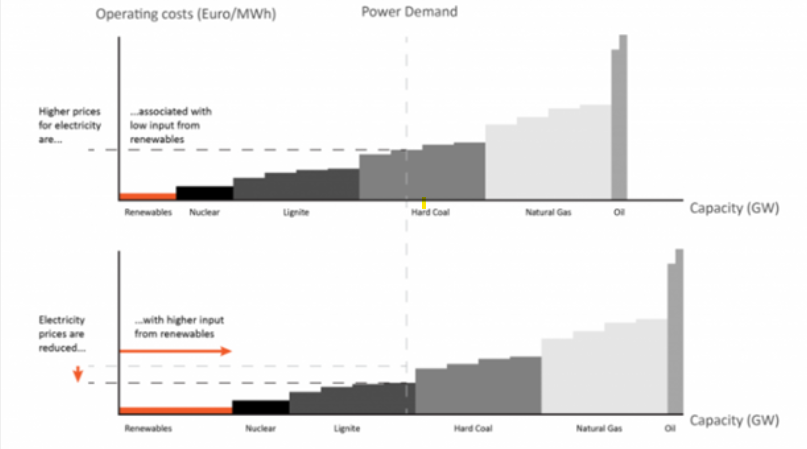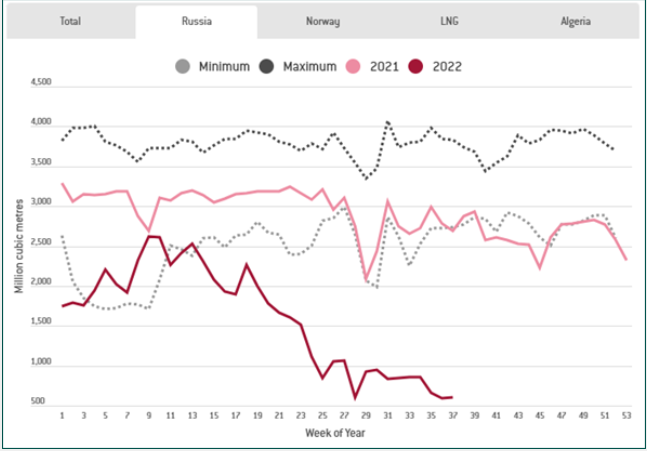
Fixed income
Understanding the challenges of the European electricity market design
Back to all
The Russia-Ukraine military war has triggered a Russia-Europe energy war that is severely impacting the European energy prices, and particularly electricity prices. These exceptional circumstances lead us to take a step back and consider how wholesale power prices are determined and how we want to shape the future design of the European electricity market.
Introduction
The Russia-Ukraine military war has triggered a Russia-Europe energy war that is severely impacting the European energy prices, and particularly electricity prices. These exceptional circumstances lead us to take a step back and consider how wholesale power prices are determined and how we want to shape the future design of the European electricity market.
German day-ahead power price in EUR/MWh

Source: Bloomberg
Today’s electricity market design in the EU
The current EU electricity market design is based on the “merit order” system, in which the power station that produces the last MWh needed in the system sets the market price.
The ‘Merit Order’ system

Source: www.cleanenergywire.org
The first graph shows that the renewable sources of power (wind, solar and hydro) have the lowest marginal cost of production, as the sun, the wind or the rain are ‘free of charge’. Because of this and because wind and solar-based electricity is non-flexible (i.e., it cannot be started whenever needed, at any time, this is an intermittent source of power dictated by natural powers), the first technology in the “merit-order” is renewable energy. Then, nuclear follows, as it has a high fixed cost but low operating costs. Next, thermal (more carbon intensive) technologies such as lignite, coal or gas follow, until the total demand for electricity is satisfied at any given time. Unlike renewables and nuclear, the operational costs of gas and coal-fired power plants are mostly variable, since the largest part of the costs is the fuel itself. Both thermal technologies also need to consider the price of CO2 emission permits under the EU Emissions Trading System as an important part of the power production cost.
This market design is called the “merit order” and defines the electricity price on the wholesale markets (i.e., the operational cost of producing the last MWh needed). In other words, the last power plant needed to meet demand in a given time frame sets the prices and all producers are paid that same price for their power.
For example, we can see on the first graph that the market price for power is determined by the last MWh produced by a coal power plant. If power demand increases, gas power plants might be needed and therefore the cost of producing that last MWh would be higher.
In addition, on the second graph above, we can see the positive price effect of the large-scale deployment of renewable sources of power which would lead to lower power prices on the wholesale market (assuming constant power demand), as the more expensive technologies (coal and gas power plants in the graph) would be pushed further away in the “merit order”. However, unless large power storage capacities can be deployed in the future, the intermittency of renewable power will always require some “back up”, usually thermal facilities, and increased interconnections across European countries.
The EU wants to quickly reduce its gas, coal and oil imports from Russia through its REPowerEU plan and Russia sharply decreased its gas exports to Europe. Clearly, we are entering a new era in which these thermal commodities will become more expensive than ever.
Russian gas exports to the EU

Source: www.bruegel.org
This ‘merit order’ market design and pricing mechanism explains the huge impact of a sharp rise in coal or gas prices on European energy prices and, in turn, on the inflation rate.
How will EU governments tackle this electricity price issue in the short-term?
The first reaction to the rapid rise in power prices across the continent took the form of support measures for (vulnerable) consumer groups, such as a decrease of the applicable VAT rate on electricity or “energy cheques”. Of course, this has an immediate impact on the final energy bill of the consumer.
A second initiative by the Spanish Prime Minister Pedro Sanchez pushed for a change of the “merit order” so the price of electricity is decoupled from the price of gas. This is particularly important to Spain and Portugal, which have very high renewable electricity generation and are almost completely decoupled from the rest of the EU energy market because of poor connections over the Pyrenees.
A third initiative saw some European countries tax the supposed exceptional profits of power generators as a result of these exceptional market circumstances. These are the so-called “windfall profits taxes” that are supposed to finance the VAT reductions, “energy checks” or similar public initiatives. Without entering into too many details, it is questionable whether such “windfall taxes” should be applied to all power volumes. Indeed, most of the generated power is traditionally sold forward in the market (i.e. hedged) and therefore does not generate exceptional profits in the short term. Exceptional profits would only be cashed-in through the hedges or forward sale of future power volumes that will be generated in two or three years, but not now.
If not adequately fine-tuned, such “windfall profits taxes” may risk jeopardising investor confidence or act as a disincentive to invest.
Finally, in early September, the European Commission announced a price cap for European power:
The EC confirmed it will be introducing a EUR 180/MWh cap on power generators’ revenues. However, the devil can be in the details: the Energy Commissioner, Kadri Simson, specified that member-states are allowed to set lower price caps per technology if they wish to do so. But a patchwork of different price caps, unilaterally introduced by individual EU countries, would create investment uncertainty, warned WindEurope: “
An EU-wide cap on revenues from wind should be precisely that – a single EU-wide cap. Allowing countries to deviate from it and have lower caps creates confusion and uncertainty – and will slow down the investments we so badly need
,” said WindEurope’s CEO Giles Dickson. Similar fears have been voiced by the solar power industry: “
We greatly regret the possibility that is preserved for member states to set a lower cap on revenues at national level. This creates high uncertainty for investors and endangers the integrity and unity of the EU market. The European Commission should set a European-wide base level of proportionality for the new cap measures
” said Naomi Chevillard, head of regulatory affairs at SolarPower Europe.
This is not a EUR 180/MWh cap on power prices per se. At this stage, there is no change in the wholesale market price formation mechanism described above. The wholesale power market is not impacted and will continue to work exactly as it does today. Instead, the mechanism is an ex-post clawback on surplus revenues per MWh of electricity produced. In other words, a generator selling power at, say, EUR 500/MWh will have to pay the EUR 320/MWh it earns above the cap back to its government. The money collected is then to be channelled to final electricity customers to help reduce the impact of rising energy costs.
The cap will apply to all power generators whose marginal costs are lower than the cap i.e., the renewables and nuclear-based power generators in the first line. It will not include gas-fired power generation. The cap has been set at the seemingly generous level of EUR 180/MWh to avoid jeopardising profitability of future new-build investments.
The cap will apply to all power sales, including hedges and bilateral contracts as well as Power Purchase Agreements (commercial PPAs are medium-to-long term power-purchase contracts between a corporate and a power generator giving visibility on volumes and prices for both parties), and not just to spot market sales. However, any contracts struck below the cap will not be affected, nor will power sold under existing fixed-price feed-in tariffs or two-way Contract For Differences or revenues from e.g. green certificates (these are all subsidised/incentivized tariffs applied for renewables technologies).
The cap is only to apply until March 31, 2023, as things stand. I believe we can expect some form of extension further away in 2023.
In the medium to long term, how should the European electricity market evolve?
For now, the wholesale power price is set by the most expensive fuel. However, the viability of the current power market design, notably in terms of investment signals, is questionable, especially in the long term, when renewables’ (with no fuel cost and a variable cost close to nil) market share approaches 100% in some countries.
A report on the wholesale EU power market, released in April 2022 by the Agency for the Cooperation of Energy Regulators (ACER), which unites national energy regulators in Europe, concluded that the « merit order” model, even if not “fully future-proof”, is better equipped to shield EU consumers from even higher volatility than other types of market design. Moreover, the “merit order” model also allows clean energy sources with higher capital and lower operational costs to cover those capital costs, and it incentivises emerging technologies that allow for flexibility, such as energy storage or demand-side responses. Finally, the ACER report cautions to prudently consider the need for interventions in electricity market functioning given the current circumstances. If deemed necessary, then policymakers should at least make sure to tackle the root cause of the problem (current gas prices) rather than the electricity market framework itself.
Given the renewed impetus to diversify the EU’s gas supply, gas prices are likely to be increasingly determined by the global LNG market in the coming years. Accordingly, this ACER assessment considers some of the key developments impacting the LNG market. In particular, ACER suggests for policy makers and others to pay close attention to mechanisms that can limit gas price exposure and secure additional gas supplies to offset decreasing supplies of Russian gas. Such measures include for example enhanced long-term contracting and higher gas storages. However, both measures do come at a cost.
Price signal for renewables deployment
The EU needs massive additions of low-carbon electricity generation to reach its decarbonisation objectives and to increase its energy independence. The huge deployment of these additional renewable power generation capacities and of the additional interconnection capacities between countries embedded in the REPower EU and the Fit For 55 plans require clear long-term price signals such as:
public support schemes (contracts for difference (CfDs), feed-in tariffs, feed-in premiums, etc.);
a framework boosting the development of commercial PPAs in Europe;
longer-term hedging instruments for power generators (current hedging instruments are only tradable/liquid for up to 2-3 years).
Price signal for increased flexibility of the European electricity system
A vast share of renewable generation is intermittent. As such, price volatility is bound to rise. Hence, the future market design will also need to send adequate price signals to meet flexibility needs going forward. Fossil fuel power plants (such as gas and coal-fired power plants) and hydro power plants with large reservoirs can provide the needed flexibility to compensate for renewables’ intermittency. When phasing out fossil fuels, alternatives to provide this type of flexibility will be needed. Such alternatives could include low-carbon fuels (such as low-carbon hydrogen, bio-methane and biomass) or more flexible renewables. In addition, increased storage of (renewable) gases, diversification of resources and better interconnections for electricity and (renewable) gases can enhance the flexibility of these technologies.
A clear price signal is essential to attract investment in such flexible resources. In the absence of such a price signal, innovation in new technologies, which might not always be price-competitive with fossil fuels, will be hampered or may not materialize at all.
Finally, determining the value of a flexible electricity system can also take the form of financial incentives paid to consumers who accept to reduce their electricity consumption when the system needs it (so called “demand response”). A first tangible sign of this can be found the in the European Commission recent announcement of a mandatory 5% reduction in EU power consumption during peak hours (implementation details still need to be decided).
Conclusion
The European electricity market prices are strongly distorted by the current Russian gas supply constraints. While explaining the basics of the electricity price formation, we underlined the need for adequate future price signals to ensure the targeted deployment of more renewable energy in Europe and guarantee the necessary flexibility of its electricity system.
Disclaimer
Degroof Petercam Asset Management SA/NV (DPAM) l rue Guimard 18, 1040 Brussels, Belgium l RPM/RPR Brussels l TVA BE 0886 223 276 l
Marketing Communication. Investing incurs risks.
The views and opinions contained herein are those of the individuals to whom they are attributed and may not necessarily represent views expressed or reflected in other DPAM communications, strategies or funds.
The provided information herein must be considered as having a general nature and does not, under any circumstances, intend to be tailored to your personal situation. Its content does not represent investment advice, nor does it constitute an offer, solicitation, recommendation or invitation to buy, sell, subscribe to or execute any other transaction with financial instruments. Neither does this document constitute independent or objective investment research or financial analysis or other form of general recommendation on transaction in financial instruments as referred to under Article 2, 2°, 5 of the law of 25 October 2016 relating to the access to the provision of investment services and the status and supervision of portfolio management companies and investment advisors. The information herein should thus not be considered as independent or objective investment research.
Past performances do not guarantee future results. All opinions and financial estimates are a reflection of the situation at issuance and are subject to amendments without notice. Changed market circumstance may render the opinions and statements incorrect.